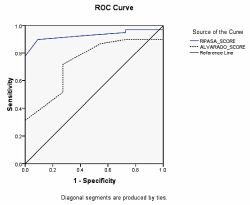A Comparative Analysis Between RIPASA and Alvarado Scoring Systems for the Diagnosis of Acute Appendicitis- A Nepalese Perspective
Keywords:
Acute Appendicities, Alvarado Score, RIPASAAbstract
Introduction: Various diagnostic criteria have been described for acute appendicitis. For decades the most commonly used one has been Alvarado score. RIPASA scoring system has also been developed for Asian population which has shown highest sensitivity and diagnostic accuracy. This study aimed to compare these two diagnostic criteria in Nepalese population attending a tertiary center.
Methods: Patients with clinically suspected acute appendicitis were classified according to both Alvarado and RIPASA scoring systems before undergoing surgery. Histopathological examination was taken as the gold standard for diagnosis. Statistical analysis was done using McNemar's test as applicable.
Results: Ninety nine (90 %) patients had histologically confirmed appendicitis. With the cut-off value greater than 7.5 for RIPASA score; sensitivity, specificity, positive predictive value, negative predictive value, diagnostic accuracy and negative appendectomy rates were 94.5%, 27.27 %, 92.16 %, 37.5 %, 88.18% and 7.84% respectively. With the cut-off value greater than 7 for Alvarado score, sensitivity, specificity, positive predictive value, negative predictive value, diagnostic accuracy and negative appendectomy rates were 71.72%, 72.73 %, 95.95 %, 22.22%, 71.82 %, and 4.05 % respectively. 94.5% of patients were correctly stratified by RIPASA under higher probability group while only 71.8 % were classified by Alvarado (p value= 0.0001).
Conclusion: RIPASA scoring system showed high sensitivity and diagnostic accuracy in comparison to Alvarado scoring system. So, this method can be applied in Nepalese setting for the diagnosis of acute appendicitis.
Downloads

Downloads
Published
How to Cite
Issue
Section
License
The Journal of Lumbini Medical College (JLMC) publishes open access articles under the terms of the Creative Commons Attribution(CC BY) License which permits use, distribution and reproduction in any medium, provided the original work is properly cited.JLMC requires an exclusive licence allowing to publish the article in print and online.
The corresponding author should read and agree to the following statement before submission of the manuscript for publication,
License agreement
In submitting an article to Journal of Lumbini Medical College (JLMC) I certify that:
- I am authorized by my co-authors to enter into these arrangements.
- I warrant, on behalf of myself and my co-authors, that:
- the article is original, has not been formally published in any other peer-reviewed journal, is not under consideration by any other journal and does not infringe any existing copyright or any other third party rights;
- I am/we are the sole author(s) of the article and have full authority to enter into this agreement and in granting rights to JLMC are not in breach of any other obligation;
- the article contains nothing that is unlawful, libellous, or which would, if published, constitute a breach of contract or of confidence or of commitment given to secrecy;
- I/we have taken due care to ensure the integrity of the article. To my/our - and currently accepted scientific - knowledge all statements contained in it purporting to be facts are true and any formula or instruction contained in the article will not, if followed accurately, cause any injury, illness or damage to the user.
- I, and all co-authors, agree that the article, if editorially accepted for publication, shall be licensed under the Creative Commons Attribution License 4.0. If the law requires that the article be published in the public domain, I/we will notify JLMC at the time of submission, and in such cases the article shall be released under the Creative Commons 1.0 Public Domain Dedication waiver. For the avoidance of doubt it is stated that sections 1 and 2 of this license agreement shall apply and prevail regardless of whether the article is published under Creative Commons Attribution License 4.0 or the Creative Commons 1.0 Public Domain Dedication waiver.
- I, and all co-authors, agree that, if the article is editorially accepted for publication in JLMC, data included in the article shall be made available under the Creative Commons 1.0 Public Domain Dedication waiver, unless otherwise stated. For the avoidance of doubt it is stated that sections 1, 2, and 3 of this license agreement shall apply and prevail.
Please visit Creative Commons web page for details of the terms.



